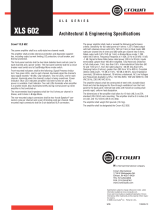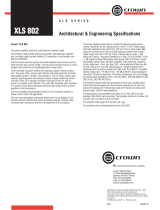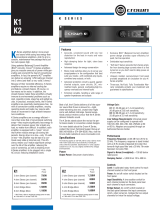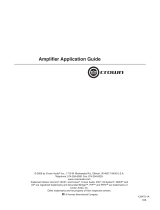
XLS Series Power Amplifi ers
Operation Manual
page 11
NOTE: For detailed information about
these Crown amplifi er features, please
consult the Crown Amplifi er Application
Guide, available on the Crown website
at www.crownaudio.com.
5.1 Protection Systems
Your Crown amplifi er provides extensive pro-
tection and diagnostic capabilities, including
built-in anti-clip limiters, switchable high-pass
fi lters, output current limiting, DC protection,
fuses, and special thermal protection for the
unit’s transformers.
5.1.1 Anti-Clip Limiters
Your Crown amplifi er has built-in Anti-Clip
Limiters which offer a degree of protection
to your loudspeakers. The Anti-Clip Limiters
work by dynamically reducing the amplifi er
gain if the output stage is driven into clip,
thereby reducing potentially damaging distor-
tion to moderate levels.
While some audio systems may already con-
tain protective limiters preceeding the amplifi er
in the system, additional use of the Anti-Clip
Limiters generally will not noticably affect
output quality. For systems without additional
protection, use of the Anti-Clip Limiters can
enhance your system’s output quality and pre-
vent catastrophic damage to your speakers.
Regardless of whether or not the Anti-Clip Lim-
iters are enabled, your amplifi er should never
be operated at a level which causes the front-
panel Clip LEDs to illuminate constantly. While
the Anti-Clip Limiters help to prevent damage
due to signal distortion, your speakers can still
be damaged by excess power dissipation.
The Anti-Clip limiters are enabled by moving
the rear-panel Limiter switch to the “IN” posi-
tion (see Figure 5.1).
5.1.2 High-Pass Filters
Very low frequency signals contain no useful
musical energy, waste valuable amplifi er power
and headroom, and can be damaging to
5 Advanced Features
and Options
your speakers. Your Crown amplifi er provides
switchable high-pass fi lters to remove these
signals from each channel’s output.
For each channel, a back-panel, three-position
switch provides optional settings of 30 Hz
(left), 15 Hz (center), or OFF (right) (see Figure
5.2). The 30 Hz setting is suitable for all full-
range and low-frequency applications. The 15
Hz setting may be selected when the amplifi er
is being used to drive a sub-bass program;
use only with speakers that provide a useful
frequency response below 30 Hz. The OFF set-
ting provides bypass of the high-pass fi lters,
for use when subsonic protection is provided
elsewhere in the system.
5.1.3 Output Current Limiting
Output Current Limiting circuitry protects the
amplifi er output stage from damage caused by
short circuit loads.
5.1.4 DC Protection
DC Protection disconnects the loudspeaker
load in the event of an output DC offset exceed-
ing 2V. In such an
event the yellow Fault LED
will illuminate (see Figure 5.3) and both amplifi er
channels will be muted. In the majority of
cases,
DC protection is indicative of a faulty amplifi er
channel, and will be accompanied by an illumi-
nated Clip LED, even with no input connected
and level controls set at minimum. If this is the
case, contact your dealer or service center.
5.1.5 Fuse
The high-voltage power supplies of your
Crown amplifi er are protected by a fuse. The
fuse rating varies depending on model and
supply voltage as follows.
230V 120V
XLS202 T6.3A T6.3A
XLS402 T6.3A T10A
XLS602 T6.3A T10A
The fuse rating for your amplifi er will also
be indicated on the amplifi er back panel label
below the power connector (see Figure 5.4).
Crown amplifi ers do not blow their fuses
unless something is wrong. Repeated fuse
failure typically indicates problems with the
amplifi er or installation which should be cor-
rected immediately.
Should the fuse need to be replaced, take care
to follow these precautions:
1. Remove power before replacing.
2. Never replace the fuse with a higher rating
than specifi ed; this could result in a
fi re hazard.
3. IMPORTANT: The orientation of the fuse
drawer determines the operating voltage of
your amplifi er. Should the fuse need to
be replaced, take care to replace the fuse
drawer so that the voltage numbers dis-
played on the top, left corner of the drawer
are correct for your local supply.
5.1.6 Thermal Protection
The Thermal Protection circuit will activate
should the internal heatsink temperature
exceed proper operating temperatures (194
degrees F, 90 degrees C). When the heatsink
temperature has fallen to a safe level, this
protection circuit will automatically be reset.
Principle causes of thermal protection are: 1)
Inadequate ventilation of the equipment rack;
2) Incorrect load impedance; 3) Output cable
short circuit; 4) Blocked air vent; 5) Heatsinks
in need of cleaning; 6) Cooling fan failure.
The cause of your amplifi er’s thermal protection
state should be determined and corrected as
soon as possible. Without correction, the Ther-
mal Protection circuit will typically reactivate.
Figure 5.1 Anti-
Clip Limiter switch
Figure 5.2 High-
Pass Filter switch
Figure 5.4 Ampli-
fi er fuse rating
Figure 5.3 Fault
indicator




























